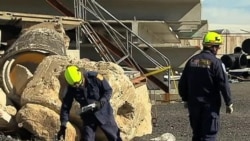LORTON, VIRGINIA —
A tracking technology NASA uses to monitor spacecraft could soon be used to find people trapped under debris on Earth. Rescuers at the Virginia Task Force 1 training facility in Lorton, Virginia, are testing the state-of-the-art radar tool.
FINDER, short for Finding Individuals for Disaster and Emergency Response, is a portable radar device that can detect even unconscious people buried beneath 10 meters of rubble by registering their slightest movements.
It is an example of a U.S. space agency innovation benefiting people here on Earth.
"FINDER works by sending a low-power microwave signal, and it illuminates the rubble pile, and some of the microwaves go in and reflect off the victim inside and come back out," said Jim Lux of NASA's Jet Propulsion Laboratory in California. "So FINDER sees both the reflection from the rubble, which does not move, and a very tiny reflection from the victim, which does move, because when you breathe and when your heart beats, your skin moves a little bit and we can see that."
The device is small, easy to carry and easy to use.
"It goes out and collects 30-seconds' worth of data, because that is how long you need to get the heartbeat and the breathing, and then it analyzes it and displays it for the user," Lux said.
FINDER would complement other tools rescuers use, such as listening devices or search dogs, as responders try to determine which buildings to search.
"This type of technology, including FINDER, could aid in the assistance of triaging a building to say, 'Okay, there is a strong probability that a live victim could be in here, and we need to devote our valuable human resources into searching it,'" said Matthew Tamillow of Virginia Task Force 1.
FINDER can also detect people who are up to 30 meters away in an open area or hidden behind six meters of solid concrete.
The device is still being tested, and NASA says it could start being used in search and rescue missions as early as next year.
FINDER, short for Finding Individuals for Disaster and Emergency Response, is a portable radar device that can detect even unconscious people buried beneath 10 meters of rubble by registering their slightest movements.
It is an example of a U.S. space agency innovation benefiting people here on Earth.
"FINDER works by sending a low-power microwave signal, and it illuminates the rubble pile, and some of the microwaves go in and reflect off the victim inside and come back out," said Jim Lux of NASA's Jet Propulsion Laboratory in California. "So FINDER sees both the reflection from the rubble, which does not move, and a very tiny reflection from the victim, which does move, because when you breathe and when your heart beats, your skin moves a little bit and we can see that."
The device is small, easy to carry and easy to use.
"It goes out and collects 30-seconds' worth of data, because that is how long you need to get the heartbeat and the breathing, and then it analyzes it and displays it for the user," Lux said.
FINDER would complement other tools rescuers use, such as listening devices or search dogs, as responders try to determine which buildings to search.
"This type of technology, including FINDER, could aid in the assistance of triaging a building to say, 'Okay, there is a strong probability that a live victim could be in here, and we need to devote our valuable human resources into searching it,'" said Matthew Tamillow of Virginia Task Force 1.
FINDER can also detect people who are up to 30 meters away in an open area or hidden behind six meters of solid concrete.
The device is still being tested, and NASA says it could start being used in search and rescue missions as early as next year.








